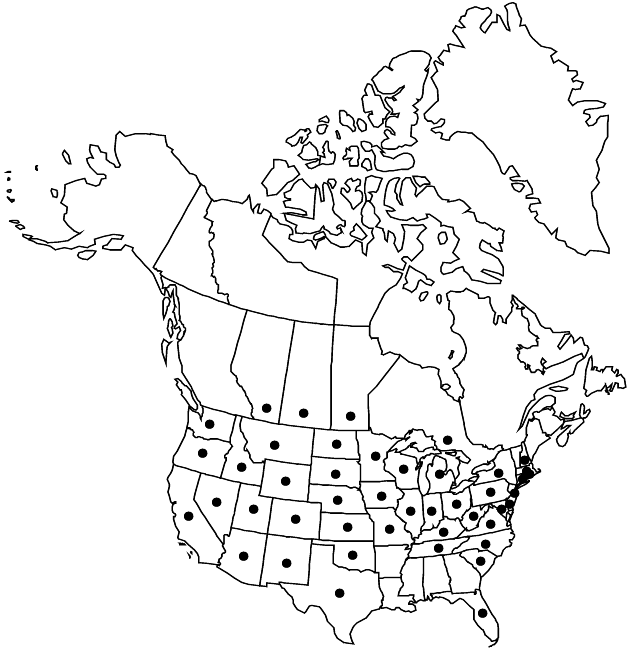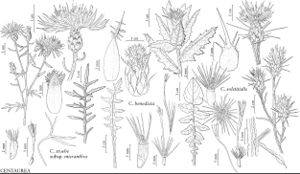Difference between revisions of "Centaurea solstitialis"
Sp. Pl. 2: 917. 1753.
FNA>Volume Importer |
imported>Volume Importer |
||
| Line 8: | Line 8: | ||
}} | }} | ||
|common_names=Yellow or Barnaby star-thistle;St. Barnaby’s thistle;centauré du solstice | |common_names=Yellow or Barnaby star-thistle;St. Barnaby’s thistle;centauré du solstice | ||
| + | |special_status={{Treatment/ID/Special_status | ||
| + | |code=I | ||
| + | |label=Introduced | ||
| + | }}{{Treatment/ID/Special_status | ||
| + | |code=F | ||
| + | |label=Illustrated | ||
| + | }} | ||
|basionyms= | |basionyms= | ||
|synonyms= | |synonyms= | ||
| Line 24: | Line 31: | ||
|elevation=0–2000 m | |elevation=0–2000 m | ||
|distribution=Widely Alta.;Man.;Ont.;Sask.;Ariz.;Calif.;Colo.;Conn.;Del.;Fla.;Idaho;Ill.;Ind.;Iowa;Kans.;Ky.;Md.;Mass.;Mich.;Minn.;Mo.;Mont.;Nebr.;Nev.;N.H.;N.J.;N.Mex.;N.Y.;N.C.;N.Dak.;Ohio;Okla.;Oreg.;Pa.;R.I.;S.C.;S.Dak.;Tenn.;Tex.;Utah;Va.;Wash.;W.Va.;Wis.;Wyo.;s Europe. | |distribution=Widely Alta.;Man.;Ont.;Sask.;Ariz.;Calif.;Colo.;Conn.;Del.;Fla.;Idaho;Ill.;Ind.;Iowa;Kans.;Ky.;Md.;Mass.;Mich.;Minn.;Mo.;Mont.;Nebr.;Nev.;N.H.;N.J.;N.Mex.;N.Y.;N.C.;N.Dak.;Ohio;Okla.;Oreg.;Pa.;R.I.;S.C.;S.Dak.;Tenn.;Tex.;Utah;Va.;Wash.;W.Va.;Wis.;Wyo.;s Europe. | ||
| + | |introduced=true | ||
|discussion=<p><i>Centaurea solstitialis</i> is a serious weed pest, especially in the western United States, where it has invaded millions of acres of rangelands, and it is listed as a noxious weed in eleven western states and two Canadian provinces. It is a strong competitor in infested areas, often forming dense colonies. It is very difficult to control or eradicate once it becomes established. In addition, yellow star-thistle is poisonous to horses; when ingested over a prolonged period it causes a neurological disorder called equine nigropallidal encephalomalacia, or “chewing disease.” Although its bitter taste and spiny heads usually deter grazing animals, horses sometimes will seek it out. Yellow star-thistle tends to spread in rangelands when more palatable plants are consumed.</p> | |discussion=<p><i>Centaurea solstitialis</i> is a serious weed pest, especially in the western United States, where it has invaded millions of acres of rangelands, and it is listed as a noxious weed in eleven western states and two Canadian provinces. It is a strong competitor in infested areas, often forming dense colonies. It is very difficult to control or eradicate once it becomes established. In addition, yellow star-thistle is poisonous to horses; when ingested over a prolonged period it causes a neurological disorder called equine nigropallidal encephalomalacia, or “chewing disease.” Although its bitter taste and spiny heads usually deter grazing animals, horses sometimes will seek it out. Yellow star-thistle tends to spread in rangelands when more palatable plants are consumed.</p> | ||
|tables= | |tables= | ||
| Line 47: | Line 55: | ||
|publication title=Sp. Pl. | |publication title=Sp. Pl. | ||
|publication year=1753 | |publication year=1753 | ||
| − | |special status= | + | |special status=Introduced;Illustrated |
| − | |source xml=https:// | + | |source xml=https://bibilujan@bitbucket.org/aafc-mbb/fna-data-curation.git/src/bb6b7e3a7de7d3b7888a1ad48c7fd8f5c722d8d6/coarse_grained_fna_xml/V19-20-21/V19_226.xml |
|tribe=Asteraceae tribe Cardueae | |tribe=Asteraceae tribe Cardueae | ||
|genus=Centaurea | |genus=Centaurea | ||
Revision as of 20:35, 27 May 2020
Annuals, 10–100 cm. Stems simple or often branched from base, forming rounded bushy plants, gray-tomentose. Leaves gray-tomentose and scabrous to short-bristly; basal and proximal cauline petiolate or tapered to base, usually absent at anthesis, blades 5–15 cm, margins pinnately lobed or dissected; cauline long-decurrent, blades linear to oblong, 1–10 cm, entire. Heads disciform, borne singly or in open leafy arrays, long-pedunculate. Involucres ovoid, 13–17 mm, loosely cobwebby-tomentose or becoming glabrous. Principal phyllaries: bodies pale green, ovate, appendages stramineous to brown, each with palmately radiating cluster of spines, and stout central spine 10–25 mm. Inner phyllaries: appendages scarious, obtuse or abruptly spine tipped. Florets many; corollas yellow, all ± equal, 13–20 mm; sterile florets slender, inconspicuous. Cypselae dimorphic, 2–3 mm, glabrous, outer dark brown, without pappi, inner white or light brown, mottled; pappi of many white, unequal bristles 2–4 mm, fine. 2n = 16.
Phenology: Flowering mostly summer–autumn (Jun–Oct), sometimes year-round in frostfree coastal habitats.
Habitat: Roadsides, fields, pastures, woodlands
Elevation: 0–2000 m
Distribution

Introduced; Widely Alta., Man., Ont., Sask., Ariz., Calif., Colo., Conn., Del., Fla., Idaho, Ill., Ind., Iowa, Kans., Ky., Md., Mass., Mich., Minn., Mo., Mont., Nebr., Nev., N.H., N.J., N.Mex., N.Y., N.C., N.Dak., Ohio, Okla., Oreg., Pa., R.I., S.C., S.Dak., Tenn., Tex., Utah, Va., Wash., W.Va., Wis., Wyo., s Europe.
Discussion
Centaurea solstitialis is a serious weed pest, especially in the western United States, where it has invaded millions of acres of rangelands, and it is listed as a noxious weed in eleven western states and two Canadian provinces. It is a strong competitor in infested areas, often forming dense colonies. It is very difficult to control or eradicate once it becomes established. In addition, yellow star-thistle is poisonous to horses; when ingested over a prolonged period it causes a neurological disorder called equine nigropallidal encephalomalacia, or “chewing disease.” Although its bitter taste and spiny heads usually deter grazing animals, horses sometimes will seek it out. Yellow star-thistle tends to spread in rangelands when more palatable plants are consumed.
Selected References
None.
